Played on Windows
Planned versions for macOS and Linux with no release date available currently.
Disclosure (review copy) at the end of the review
Into the Breach was released in February, and got a lot of publicity, but the one thing I noticed is the title of the game appeared to be “Into the Breach from the makers of FTL”. It seemed every news source used that title, and apparently, now I have. Subset Games has made that connection a major feature of the advertising of the game even showing it on the steam header image and such.
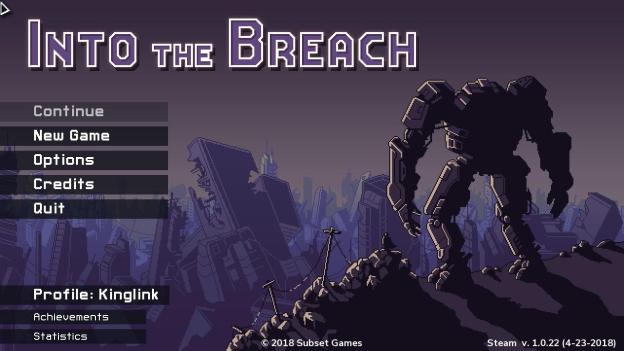
However no mention in the game here.
But the thing is the link between these two games is important. The qualities that made FTL a smash hit are still very present in Into the Breach. The amazing roguelike replayability, the addictive nature, and excellent balance in the game. Into the Breach is a sequel to FTL that’s changed the theme, the style, and mechanics but retain the design philosophy, which makes the link between the game clear beyond just promotion of the game.
Both games are rather short for a single playthrough. There is a simple to learn, hard to master style to them. Random chance does have a small effect on gameplay, but the solid gameplay is required as well to do well with the games. There are a number of differences in styles, as FTL is not turn-based, and instead is played in real time, but it’s still clear the team was the same while the subject matters changed.
The first thing that Into the Breach does is remind me of Advance Wars. I could make a case that it’s bad to have a video game style so similar to another that it draws a strong comparison out of the gate to another rather popular game, but Advance Wars hasn’t had a release in 10 years. In addition, Advance wars has never been released on PC outside of emulation, and it’s a really solid series.
Into the Breach has a modest start. You pick a team, and a difficulty, and are sent back in time (by being dropped into the breach) to try to save the world from an invading insect-like force known as the Vek. That’s about all the story you’re going to get here. You are time travelers who are trying to save Earth from some sort of Helicarrier. It’s good enough in my book, I’ve had to write enough about games that had stories and didn’t need them that I’m thrilled to play a game that understands that, and doesn’t attempt to make an overly long dialogue to justify its existence.
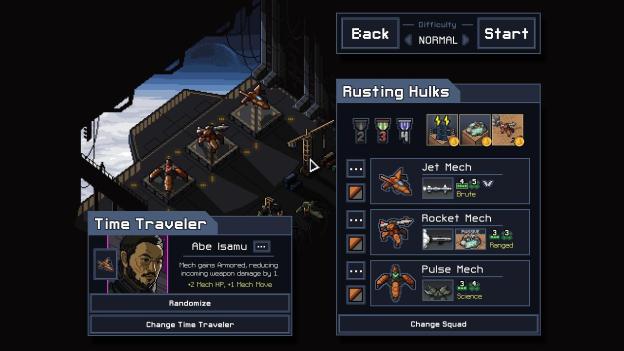
Simple beginnings.
At the beginning of the game, you only have one team, the Rift Walkers. They are the most basic team with three units that can deal direct damage, and in fact, all three can also move enemies with their attack. As a new player, you’re going to likely try to beat down the enemies with the units. That’s a normal and a good starting strategy.
From there you drop into the world with the choice of one island, though four islands are on the map, and you attack enemies. You almost definitely WILL likely lose on that island or the second one. The game is a bit hard for a first-time player, but what you will gain is knowledge of how to use your team. From there, you either will lose the timeline or abandon it and reappear on the helicarrier, potentially with a saved crew member (if you’re lucky and any survived).
This is the entire gameplay loop. You choose a team and a pilot, drop in, play as much of the game as you can, potentially winning but ultimately restarting again after the end of a timeline. You’re allowed to carry over one pilot from your mechs, and then you drop in again. It’s a simple cycle but very effective. It keeps you wanting to play more because you think about the reason you lost, or a small improvement, or a new tactic that you’ve come up with.
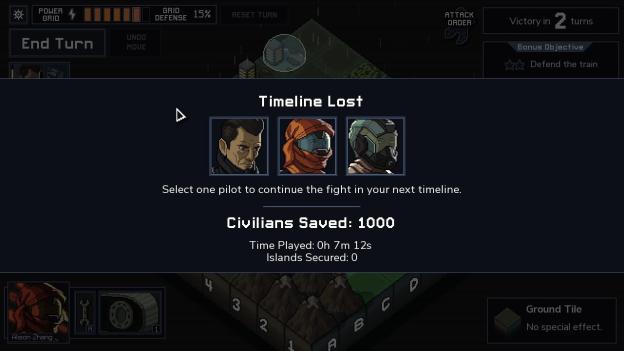
You will see this screen more times than you want to.
I recently reviewed Hearts of Iron IV and complained about the required repetition in that game to learn the game. Someone might ask “Why is it acceptable here?” and it’s a valid question. The reason is simply that you have a faster turnover rate. 30 minutes to learn a lesson is fast, whereas 5 hours to learn an important lesson is a rather long time. Fast iteration is the real difference between the two games and it makes that learning a far better experience because you can finish a few games in an hour and come out with a deeper understanding of the game.
With that said, Into the Breach is as addictive as FTL, and feels more compact and tighter. You have only three units, which means a limited number of moves and actions can be taken in a single turn. You eventually win or lose and start over. The fact that the game moves to a turn-based system allows you to take your time and avoid requiring a snap judgment. There is the ability to consider moves and that helps you form strategies that feel more sound.
The ultimate goal of Into the Breach is to beat a “final mission” which first becomes available after the second island but can also be challenged after the third or fourth island. Any island you start needs to be completed though. However, the final mission doesn’t change in difficulty, though your units will gain power by completing more islands.
Each island has a theme and a controlling corporation that needs your assistance. There are a number of missions that are available. This is done similar to how Risk is played, you need to choose a location next to a completed mission (or the starting location) for it to be accessible. Each Mission is different but the main idea that you have to slow down the Vek (the alien race) and achieve some other goals usually to earn reputation, energy and potentially power cores.
The energy system (which is called grid power) is your real life force in the game. Most levels are between three and five turns long, which isn’t really long enough for the Vek to destroy all three of your units unless you play horribly. However, the Vek’s actual goals tend to be to destroy buildings, with attacking your units being a secondary task. If the enemy can deplete your Grid Power by 1 point a turn or a map, they will eventually win just due to attrition, as running out of Grid Power ends the current timeline, which forces you to restart from the beginning and choose a squad and a difficulty again.
So with an understanding of the island and Grid power, we can talk about the actual levels the game is played on. A level is a grid-based map that spans an 8×8 layout, which you can see before you choose your level. Each level has a unique mission, and while there’s a randomness of what’s available on each map, the same missions are placed on the island in random locations.
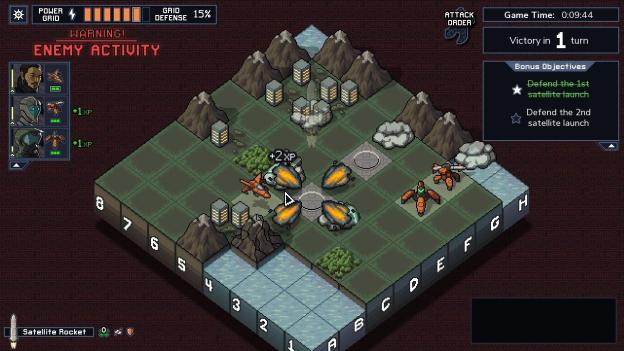
Simple looking map, but a lot of information here.
Each map is randomized as well, the enemy spawns and town locations appear to be randomly generated with some rules in place. You should always have time to get into a good position, and the enemy shouldn’t be able to get a hit on a critical space that you can’t stop on the first turn. The game itself is all played on a grid-based system. There’s a random style to each grid but you’re able to look at the layout ahead of time as you choose which map to play.
Each team has a unique strategy, but the Rift Walkers that are mentioned are pretty standard. One unit can punch the enemies in front of him for two damage and knock him back, the second unit can shoot an enemy in a straight line of sight for one damage, and knock him back, the third unit is artillery which can fire a shell two or more units away, not requiring a line of sight (so objects can’t block the shot) and will cause a single unit of damage but push all neighboring units away. It seems complicated but you should be able to understand it quickly after a turn or two
In addition, the enemy moves into place, and sets up attacks. You can see how their attacks will resolve. From there you get a full turn to stop those attacks if you wish. On your turn each of your three units is allowed a move of their move distance, and then an attack in that order for their turn. You don’t have to take a turn for each unit, but there’s almost always something for the units to do. After that, the enemy’s attacks get resolved in order. It’s relatively simple.
I really enjoy this gameplay because it has a lot of strategic edge cases to it. For instance, if the punching robot stands next to a unit with four health opposite a building, and hits him, he’ll be knocked back into the building, that gives him an extra point of damage, but it will harm the building causing a point of damage to the grid power. That’s not normally a great move, though it can be useful in some situations. Instead, if there are two units in a line, one having 1 unit of health and the other having two units of health, the canon unit can shoot the second unit into the first dealing one damage, plus one point of collision damage to each unit, and killing both. That is if he can get the correct angle on the shot.
There are so many synergies in this game and unique strategies that I could spend an hour describing them all. There are status effects such as smoke, fire, A.C.I.D, and water just to name a few, and there are so many ways each can be used. Much of the game is about figuring out those little tweaks that make your squad more effective through strategic deployment.
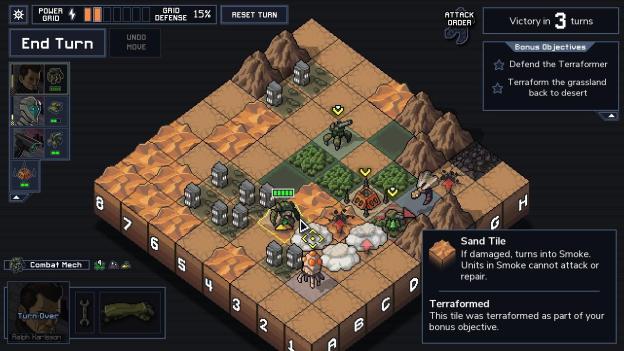
Smoke is easily my favorite status effect.
The fact I have to describe so many systems might seem like a lot but it’s because all those systems work so well together that each is important. I heavily enjoy getting randomized missions and doing work for the corporation because it’s easy to see it all adding up and after a few games you know how valuable each of those rewards are. You will have a bit of delayed gratification for some tasks but within fifteen minutes you’ll reap the benefits.
In addition, I absolutely love the start of a turn because you start making a massive plan for each unit and are able to calculate each move. Everything in the game is laid out, there’s no randomness to damage or percentage chance to the game (except for damage to buildings has a small chance of resisting it). Every move and action is planable and the results are very easy to understand here. Having only three units is a small number, but the game relies on effective use of each unit, rather than overpowering another force. The three units in Riftwalker can actually affect thirteen different squares with just the attacks they have if the enemies are set up perfectly That’s rare to happen, but you usually find a way to use these teams to get the results you want. It’s all about a strategy more than power.
I’ve talked about damaging enemies a lot but in reality, that’s a trap the game sets for early players. Damage is good, and that’s how you kill enemies, but the secret of Into the Breach is that it’s not about damage, it’s more about mitigation of enemy damage. Your objectives of each map are usually achievable, but the real trick is to avoid letting the enemy deal damage to any important square. While a direct artillery shot might cause 1 damage, it might allow the enemy to still attack a city square, instead attacking next to the enemy can push him out of the way so his attack hits a mountain. That can be a better result, and it’s strategies like that which really become apparent after a few games.
There are a number of other strategies that also come up. Letting your unit take some damage is a great example. You don’t want your unit to die, but since units get healed at the end of a level, taking a single damage to a unit is often preferable to taking the grid damage. You also can get Armor or Shield statuses for units, so one damage to them may be ignored, There’s a number of strategies that I found in later playthroughs, including damaging buildings myself, to avoid a stronger attack from the enemy that are interesting. Each one of these strategies is very satisfying if pulled off properly.
So what about the AI? The fact is the AI in the game for the enemy is solid but makes some weak moves. If you were playing against an actual human player, they should be unstoppable in this game because the game on normal should be heavily biased in the enemy’s favor when played correctly. However that wouldn’t produce the best experience, and I believe the game makes the enemy choose more interesting formations rather than ones that guarantee success.
At the same time, the AI can sometimes make excellent moves, and it produces really hard moments to deal with. I remember one game where I realized that no matter what, one of my units had to die. There was no way to save all three of my units, and I would have to lose a unit. In the game, a dead unit still gets repaired but its current pilot dies permanently. It’s a sad moment and even with generic squad members in some mechs, I never wanted a single loss. However, there was no way for me to save all three units. In the situation, I found myself I could save my second unit but would lose my third, or I could save my third but would have to watch my second unit die. It was an amazingly hard choice, and I felt terrible for my little computer-controlled characters.
Of course, if you make a mistake with your plan during a turn, that can be fixed. The game allows you to reset the current turn one time per map. It’s actually an excellent feature because I have made mistakes on my strategies when I missed something critical or forgot a side effect of an attack, and wanted a do-over. Other times there have been points where I had it available and avoided using it because I thought that I might need it on a later turn. It’s a simple feature but it is one that deserves applause for being well balanced.
Each map is controlled by a number of turns, and eventually, the turn count runs out assuming you don’t run out of grid power (the game over). All Vek on the maps disappear at the end of the timer, and unless one of the map objectives is to kill a certain number of enemies, there’s no penalty for letting the Vek escape.
After a map is over, you earn rewards depending on the objectives you complete. As mentioned you can get reputation points, grid power, and even power cores after each level. You also sometimes find Time Pods that randomly appear on maps. Collecting (or just protecting) these allow you to open it. You always get one Power Core from a Time Pod, but you have a chance at getting an extra pilot, or an additional weapon for free.
The Power Cores are essential in this game. Each Mech starts the game with one or two equipped items, these are powered by the mech’s initial power, and the main way to increase the power of the mech is the power cores. Once applied you can route the increased power to weapons to increase damage, range, add special abilities or features, or even increase the mech’s move, or health. In addition, new weapons sometimes require a unit of power to even operate.
Those power cells though will make your character feel incredibly more powerful. You can focus them on a single unit, or spread them around but by the end of the game, just by adding a few power cells, your original units can become behemoths, and that’s one of the reasons you may want to avoid going for the final battle until you beat all the maps, because of the power gains over the course of the maps and islands makes that final mission easier.
So we’ve gone over what happens in a map. Let’s take a step back and look at the islands a second time. Each island has a set number of locations, however, when only three locations are left, the island changes and the game begins a final battle for the island at the corporate HQ, with a “boss”. You can see what the boss of each island is before even entering the island, but when you face them in the final battle on an island and it’s usually a strong enemy. Boss monsters have more HP, invulnerability to some instant kills (such as dropping a unit into water), and increased damage. They don’t have to be killed (they like all Vek retreat after a certain turn) but killing a boss, and avoiding damage to the Corporate HQ will grant you additional reputation.
Reputation is the currency of each island in the game. Apparently, the fact you’re facing a monstrous race that is going to destroy the planet isn’t a big enough emergency for the corporations, and they charge you for every favor they do for you at the end of an island. You can spend your reputation after the final battle at the HQ, depending on how much reputation you gathered. There are power cells, additional grid power, and a number of weapons for purchase. It’s a system that heavily incentives beating the objectives instead of only worrying about Grid Power and your mech, though sometimes you may have to trade one for the other and make a hard choice.
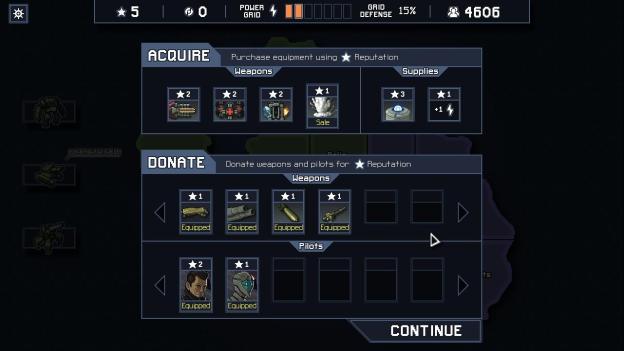
There’s not much variety in the reputation system, but it works
In addition, if you get every objective on the maps you play for a single island, you’ll earn a “perfect island” bonus. A perfect island grants the player a choice of three rewards, a special weapon, a new pilot, or two grid power. I like the extra pilots, but each choice has positives to it, so it’s up to the situation you find yourself in and what is being offered.
Each island in the game is a bit different. The first island is focused on water (instant kill for non-flying enemies) and fire effects. The second island focuses on desert titles and smoke, the third island is about ice and freezing enemies, and the final island is focused on additional damage, due to ACID effects. The final Battle actually has a couple more twists that I’ll leave for you to figure out.
That final mission though feels like the culmination of the game, just reaching it is a good feeling but feeling that you can tackle it and somehow win is great. As mentioned you do feel like you are massively powerful at the end of the game, and there have been a couple times I replayed the game with the same unit after a win or at least a late-game loss, and I asked myself. “Were these the same mechs?” Going from doing 8 damage for one shot, down to only two is a huge loss. But that’s the fun that results from properly building up your team.
In addition, I do need to talk about Achievements, I know I’m an achievement hound and I’ve avoided making my reviews heavily revolve around them, but Into the Breach has an important reason to chase achievements in the game.
There’s 55 achievements in the game, each of the ten squads has 3, that’s eight normal squads, and the customized squad and the random squad option. There’s also 5 achievements for getting meta achievements, such as rescuing a total of 100,000 citizens, 5 achievements for challenge runs (doing something for 3 islands), 5 achievements for victories, 5 achievements for pilots (mostly finding them) and 5 for achieving something on a specific island.
Each achievement earns the player a “coin”. To unlock more squads, you need to spend between 3 and 6 achievement coins, earning all 7 unlockable squads for a total of 30 coins. The achievements aren’t that hard so you’ll be able to find 30 points to unlock all the squads rather quickly. There is also a special squad if you get all 55 achievements, that will take quite a bit longer to achieve.
The thing is those squads are worth unlocking. As nice as the Rift Walkers are, I personally love the Rusting Hulks, which are often the second squad unlocked. I’ve learned to enjoy most of the squad, though I still don’t know about the Frozen Titans, the ice-themed team. Each squad has a theme and as long as you can figure it out they are all pretty powerful. It helps if you make sure any additional weapons you spend the resources to acquire fit with the team, as it’s very hard to go against the theme. So it’s probably not worth spending your reputation on a fire weapon on a team that is focused on smoke, for instance. You can but it’s just not as effective, whereas the X shaped smoke bombs are extremely valuable for that same team.
So with a full discussion of the game, there’s one more piece to talk about, the difficulty. I never beat FTL because I found it too hard, and since my time with FTL Subset games added a new Easy Mode that I’ve yet to play. I carried the failure to beat FTL as a chip on my shoulder. I swore to myself I wouldn’t go to Easy Mode in this game, at least not for a while. Well, somewhere between five and ten hours into the game, I unlocked a decent amount of the squads and was nowhere close to the winning the game, in fact, I only reached the final mission once (though I had the option more than once).
So I switched to Easy Mode and won in my first full playthrough. Easy mode appears to only have less spawning Vek. That’s the only change the game claims, and it seems as simple as a single Vek doesn’t appear each turn, but having fewer enemies appear giving you time to deal with enemies effectively. Normal Mode felt like I had a 90 percent chance of losing, where Easy mode gave me a 90 percent chance of winning. I actually played much of the rest of my time on Easy Mode, enjoying the game even more, and eventually winning with almost every team I attempted. However I returned to Normal mode with my favorite team, the Rusting Hulks, expecting to again face impossible odds and lose. Instead, I won on my first attempt.
You see, my time on Easy Mode wasn’t just building up my confidence, I was learning valuable tactics and how to deal with units and boards more strategically and with less blunt force moves. Those changes made me a better player on Normal, and maybe one day I’ll even try Hard Mode, though that still terrifies me.
In total, I played Into the Breach for over twenty-one hours, and I want to play more, I do want to tackle Hard Mode when I can get the nerve up. The thing is I really enjoy Into the Breach, and I think it’s got some interesting links to strategic games, Advance Wars, Chess, and of course FTL. There’s a deserved link to all of these games from Into the Breach.
I completed those twenty-one hours before feeling like I had to move on to The Humble Bundle games for August 2018. I will likely return and put in more time later. Into the Breach though retails for 15 bucks and honestly, it’s a game I think that will surprise a lot of people. It is a good strategy game but not something that’s inaccessible to people who don’t think strategically at first. I easily got my money’s worth and more, and the fact is Into the Breach really shines. It’s something everyone should at least take a look at, and because of that, Into the Breach earns my second
5/5
I don’t really have many negatives in this review, and it’s because Into the Breach shines brightly in almost every way. If you can accept a strategic game, check this one out. If you want action, you won’t really find it here, and the graphics are made for the style of game it is, but if you liked FTL, or you are open to a slower paced strategic game you’ll easily find that here.
Final Thoughts: A Worthy “sequel” to FTL, and a really interesting and fun strategic game. It feels like Advance Wars in many ways and is remarkably playable and enjoyable.
Stats 21.8 hours played 37/55 achievements earned
I reached out to Subset Games to ask for a copy. They gave me a copy which I thank them for. This has not affected my review but is included here as a matter of disclosure.
